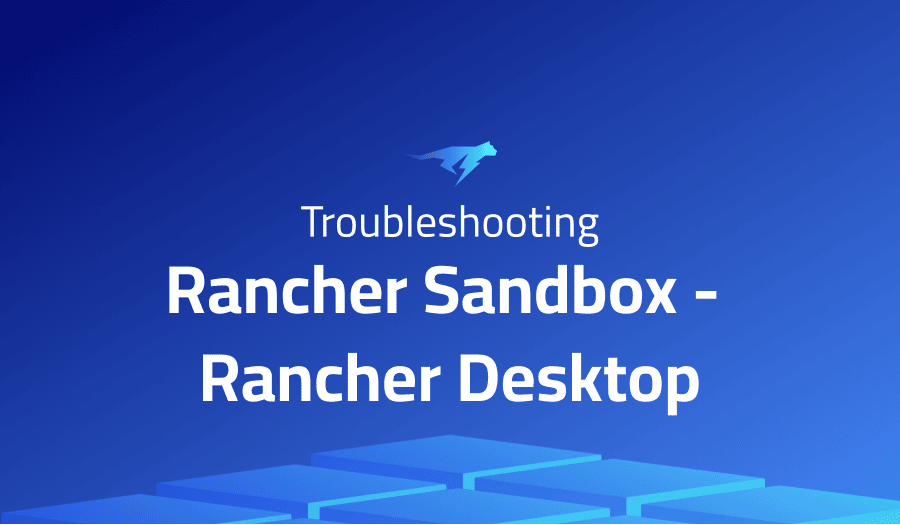

Troubleshooting Common Issues in Rancher Sandbox – Rancher Desktop
Project Description
Rancher Sandbox is a tool that allows users to run and experiment with Rancher, a popular open-source platform for managing containerized applications. Sandbox provides users with a pre-configured environment that includes a Rancher server and several host nodes, all running in Docker containers. This allows users to try out Rancher and get a feel for how it works without having to set up a complex and potentially costly infrastructure.
Rancher Desktop is a standalone application that allows users to manage Rancher environments from their desktop. It provides a graphical interface for managing containerized applications and includes features such as container monitoring, resource management, and deployment tools.
Rancher Desktop is built on top of the Rancher Sandbox environment, which means that users can easily switch between the two depending on their needs.
Troubleshooting Rancher Sandbox – Rancher Desktop with the Lightrun Developer Observability Platform
Lightrun is a Developer Observability Platform, allowing developers to add telemetry to live applications in real-time, on-demand, and right from the IDE.
- Instantly add logs to, set metrics in, and take snapshots of live applications
- Insights delivered straight to your IDE or CLI
- Works where you do: dev, QA, staging, CI/CD, and production
The most common issues for Rancher Sandbox – Rancher Desktop are:
Error: wsl.exe exited with code 4294967295
The error message wsl.exe exited with code 4294967295 suggests that there is a problem with the Windows Subsystem for Linux (WSL), which is a compatibility layer for running Linux binaries on Windows.
There are a few potential causes for this error:
- The WSL feature is not enabled on your system. In order to use Rancher Sandbox or Rancher Desktop, you will need to enable the WSL feature in Windows. To do this, go to the “Turn Windows features on or off” settings page, scroll down to the “Windows Subsystem for Linux” entry, and check the box next to it. Then, click “OK” and restart your computer.
- There is a problem with the WSL configuration on your system. If you’ve already enabled the WSL feature, try running the
wsl --list --allcommand in a command prompt to see if any WSL distributions are listed. If there are no distributions listed, try running thewsl --importcommand to import a distribution. - There is a problem with the WSL version on your system. Make sure that you are running the latest version of the WSL feature, as older versions may be incompatible with Rancher Sandbox or Rancher Desktop. To update the WSL feature, go to the Microsoft Store and search for “Windows Subsystem for Linux”.
Chown error on bind mount when trying to launch postgres via docker compose
A “chown error” typically means that you are trying to change the owner or group of a file or directory, but you don’t have the necessary permissions.
To troubleshoot this issue, you can try the following steps:
- Make sure that you are running Docker and Docker Compose with the correct permissions. Depending on your system, you may need to run these commands with
sudoor as a user with the correct permissions. - Check the ownership and permissions of the file or directory that you are trying to mount. Make sure that the owner and group are set correctly, and that the permissions allow the necessary access.
- Check the ownership and permissions of the mount point (the directory where the volume is being mounted). Make sure that the owner and group are set correctly, and that the permissions allow the necessary access.
- Check the logs for Docker and Docker Compose for any additional error messages or clues about the cause of the problem.
Rancher-desktop fails to start on macOS with `sudo: a password is required` while running lima
This error message usually means that the sudo command is being used to run a command as the superuser (root), but the system is prompting for a password because the current user is not in the sudoers file.
To troubleshoot this issue, you can try the following steps:
- Make sure that you are running the
limacommand with the correct syntax. For example, you might need to use thesudocommand to runlimawith the necessary permissions, like this:sudo lima. - Make sure that you are entering the correct password when prompted. If you are unsure of the password, you can try logging in as the superuser (root) and changing the password, or you can contact your system administrator for assistance.
- Make sure that you are a member of the
sudoersfile. This file controls who is allowed to use thesudocommand. If you are not in thesudoersfile, you can try adding yourself to the file, or you can contact your system administrator for assistance.
Error Starting Kubernetes on Windows
Here are a few general suggestions that might help:
- Make sure that you have installed all of the necessary software and dependencies. This might include Docker, Rancher Desktop, and any other tools or libraries that are required for your setup.
- Check the logs for Rancher Desktop and Docker for any error messages or clues about the cause of the problem. These logs might be available in the application itself, or they might be stored in a separate file on your system.
- Make sure that you have the necessary permissions to start Kubernetes. Depending on your system, you may need to run the command as the superuser (root) or as a user with the correct permissions.
- Check for any known issues or workarounds for starting Kubernetes on Windows using Rancher Desktop. You might be able to find this information in the Rancher Desktop documentation, on the Rancher website, or by searching online.
It’s Really not that Complicated.
You can actually understand what’s going on inside your live applications.




